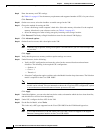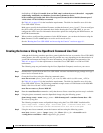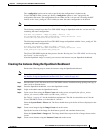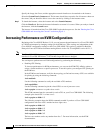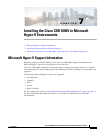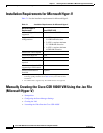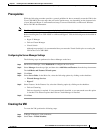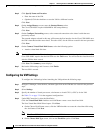
6-7
Cisco CSR 1000V Series Cloud Services Router Software Configuration Guide
OL-27477-07
Chapter 6 Installing the Cisco CSR 1000V in KVM Environments
Creating the Cisco CSR 1000V KVM Instance on OpenStack Using the .qcow2 File
The --config-drive option can be used to specify that the configuration is loaded on the
Cisco CSR 1000V when it comes up. Set the --config-drive option to “true” and specify the
configuration file name. The configuration file can either use the “ovf-env.xml” file using the OVF
format, or the “iosxe_config.txt” file in which you enter the router configuration to be booted.
Note These file names are hard-coded and required for the config-drive settings to boot.
The following example boots the Cisco CSR 1000V image on OpenStack with the “ovf-env.xml” file
containing the router configuration:
nova boot csr_instance --image csr_image --flavor 6 --nic
net-id=546af738-bc0f-43cf-89f2-1e2c747d1764 --config-drive=true --file
ovf-env.xml=/opt/stack/csr/files/ovf-env.xml
The following example boots the Cisco CSR 1000V image on OpenStack with the “iosxe_config.txt” file
containing the router configuration:
nova boot csr_instance --image csr_image --flavor 6 --nic
net-id=546af738-bc0f-43cf-89f2-1e2c747d1764 --config-drive=true --file
iosxe_config.txt=/opt/stack/iosxe_config.txt
The Cisco CSR 1000V begins the boot process. See the “Booting the Cisco CSR 1000V and Accessing
the Console” section on page 8-1.
After the OpenStack image is created, you can access the instance on your OpenStack dashboard.
Creating the Instance Using the OpenStack Dashboard
Perform the following steps to create the instance using the OpenStack dashboard.
Note To configure the KVM to run with config-drive, you must use the procedure described in the “Creating
the Instance Using the OpenStack Command Line Tool ” section on page 6-6.
Step 1 Download the .qcow2 file from the Cisco CSR 1000V software installation image package and copy it
onto a local or network device.
Step 2 From the OpenStack dashboard, access the OpenStack console.
Step 3 Login as the admin onto the OpenStack console.
Step 4 Create a new flavor using the Flavor Create tab on the screen, and specify the <flavor_name>
<flavor_id> <ram size MB> <disk size GB> <num_ vCPUs>.
See Table 6-1 on page 6-2 for the installation requirements. The disk size should be set to 0 for the
Cisco CSR 1000V to boot. as in the tables 6-1 and 6-2.
Select the System Panel > Flavors tab. The flavor should show up in the list of flavors displayed on the
screen.
Step 5 Create a new image using the Image Create tab on the screen.
Specify the location of the image, the disk format (qcow2) and container-format (raw).
Select the System Panel > Images tab. The image should show up on the list of images shown on the
screen.
Step 6 Create a new instance using the Instance Create tab on the screen.








